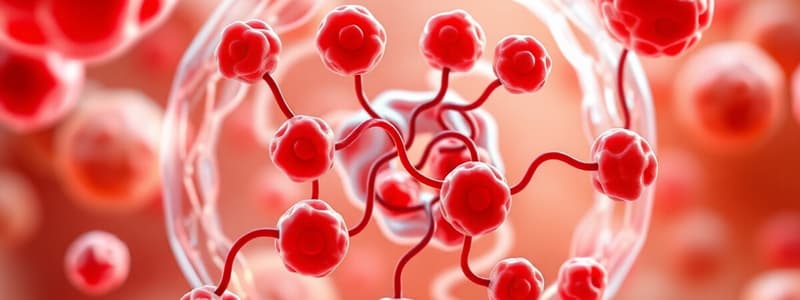Podcast
Questions and Answers
What is the primary energy yield from anaerobic glycolysis per glucose molecule?
What is the primary energy yield from anaerobic glycolysis per glucose molecule?
- 6 ATP
- 38 ATP
- 8 ATP
- 2 ATP (correct)
How many ATPs are generated by one molecule of NADH in the electron transport chain?
How many ATPs are generated by one molecule of NADH in the electron transport chain?
- 3 ATP (correct)
- 2 ATP
- 1 ATP
- 4 ATP
Which of the following conditions primarily leads to anaerobic glycolysis?
Which of the following conditions primarily leads to anaerobic glycolysis?
- Sufficient oxygen availability
- Mitochondria presence
- Intensive exercise (correct)
- Increased blood flow
Which hormone induces the long-term regulation of glycolysis through enzyme synthesis?
Which hormone induces the long-term regulation of glycolysis through enzyme synthesis?
What is the total ATP yield from complete aerobic oxidation of one glucose molecule?
What is the total ATP yield from complete aerobic oxidation of one glucose molecule?
What is the main function of glycolysis?
What is the main function of glycolysis?
Which of the following is an end product of aerobic glycolysis?
Which of the following is an end product of aerobic glycolysis?
What occurs in cells that undergo anaerobic glycolysis?
What occurs in cells that undergo anaerobic glycolysis?
Which enzyme acts as a key regulatory step in glycolysis by converting fructose-6-phosphate to fructose-1,6-bisphosphate?
Which enzyme acts as a key regulatory step in glycolysis by converting fructose-6-phosphate to fructose-1,6-bisphosphate?
What does glycolysis primarily convert glucose into during its metabolic process?
What does glycolysis primarily convert glucose into during its metabolic process?
Flashcards are hidden until you start studying
Study Notes
Glycolysis
- Breakdown of glucose into pyruvate
- Main function: energy production in the form of ATP
- Occurs in the cytosol of all tissues
- All sugars can be converted to glucose and metabolized by glycolysis
Key Steps of Glycolysis
- Glucose-6-phosphate formed from glucose, catalyzed by glucokinase or hexokinase
- Fructose-6-phosphate formed from glucose-6-phosphate, catalyzed by phosphohexose isomerase
- Fructose-1,6-bisphosphate formed from Fructose-6-phosphate, catalyzed by phosphofructokinase (PFK) (rate-limiting enzyme)
- Glyceraldehyde-3-phosphate and Dihydroxyacetone phosphate (DHA-P) formed from Fructose-1,6-bisphosphate, catalyzed by aldolase A
- 1,3-Bisphosphoglycerate formed from Glyceraldehyde-3-phosphate, catalyzed by glyceraldehyde-3-phosphate dehydrogenase, generating NADH
- 3-Phosphoglycerate formed from 1,3-Bisphosphoglycerate, catalyzed by phosphoglycerate kinase, generating ATP (substrate-level phosphorylation)
- 2-Phosphoglycerate formed from 3-Phosphoglycerate, catalyzed by phosphoglycerate mutase
- Phosphoenolpyruvate (PEP) formed from 2-Phosphoglycerate, catalyzed by enolase
- Pyruvate formed from PEP, catalyzed by pyruvate kinase, generating ATP (substrate-level phosphorylation)
End Products of Glycolysis
- Aerobic Glycolysis: Occurs in cells with mitochondria and adequate oxygen supply. Generates 2 pyruvate, 2 NADH.
- Pyruvate enters the mitochondria and is converted to acetyl CoA, which enters the citric acid cycle for further ATP production
- NADH utilizes mitochondria and oxygen to yield additional energy
- Anaerobic Glycolysis: Occurs in cells without mitochondria or adequate oxygen supply. Generates 2 lactate.
- Lactate formed from pyruvate by utilizing NADH
Energy Yield from Glycolysis
- Anaerobic Glycolysis: Net yield of 2 ATP per glucose molecule. Important for tissues with limited oxygen supply (e.g. skeletal muscles during intense exercise), and tissues without mitochondria (e.g. red blood cells)
- Aerobic Glycolysis: Net yield of 8 ATP per glucose molecule, plus 2 NADH.
- 2 NADH produce 6 ATP when entering the electron transport chain in mitochondria. Total aerobic glycolysis yield is 2 + 6 = 8 ATP.
- Complete aerobic oxidation of glucose: 2 pyruvate converted to 2 acetyl CoA, generating 6 ATP.
- 2 acetyl CoA entering the citric acid cycle produce 24 ATP. Total yield from complete aerobic oxidation is 38 ATP per glucose molecule.
Regulation of Glycolysis
- Short-term regulation: Enzyme activity is influenced by substrate availability, product inhibition, and allosteric effectors.
- Long-term regulation: Synthesis and degradation of glycolytic enzymes are influenced by hormones like insulin (induction) and glucagon (repression).
Key Enzymes in Glycolysis
- Glucokinase (liver) and Hexokinase (other tissues): regulate glucose entry into glycolysis
- Phosphofructokinase (PFK): rate-limiting enzyme of glycolysis, regulated by allosteric effectors (ATP, AMP, citrate, fructose-2,6-bisphosphate)
- Pyruvate kinase: catalyzes the final step of glycolysis, regulated by phosphorylation (insulin and glucagon)
Genetic Defects of Glycolytic Enzymes
- Pyruvate kinase deficiency: Reduces glycolysis rate and ATP production, leading to hemolytic anemia due to impaired red blood cell function.
Studying That Suits You
Use AI to generate personalized quizzes and flashcards to suit your learning preferences.




